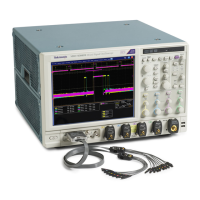Commands Listed in Alphabetical Order
NOTE. Setting t
he DESER and ESER to the same value allows only those codes
to be entered into the Event Queue and summarized on the ESB bit (bit 5) of the
Status Byte Register. Use the *ESE commandtosettheESER.
Examples
DESE 20 9 sets the DESER to binary 11010001, which enables the PON, URQ,
EXE and OPC bits.
DESE? might return :DESE 186, showing that the DESER contains the binary
value 10111010.
DIAg:CONTROL:HALT
This command determines or queries whether the next execution of diagnostics
looping will stop on the first diagnostic failure that occurs or will continue to
loop on the s elected set of diagnostic functions. This command is equivalent to
selecting Instrument Diagnostics from the Utilities menu and then enabling Halt
on Fail.
Group
Diagnostics
Syntax
DIAg:CONTROL:HALT {ON|OFF|<NR1>}
DIAg:CONTROL:HALT?
Related Commands
DIAg:CONTROL:LOOP
Arguments
ON enables the halt function, causing the execution of diagnostics looping to halt
at the first diagnostic failure that occurs.
OFF disables the halt looping function, allowing the instrument to continue to loop
on the entire set of diagnostics, even if diagnostic failure occurs.
<NR1> = 0 enables the halt function; any other value disables the halt function.
Examples
DIAG:CONTROL:HALT ON enables the halt function, causing the execution of
diagnostics looping to halt at the first diagnostic failure that occurs.
DIAG:CONTROL:HALT? might return :DIAG:CONT ROL:HALT 0, indicating that
the halt function is enabled.
DIAg:CONTROL:LOOP
This command determines or queries whether the next execution of diagnostics
executes once or continuously loops on the selected set of diagnostics (assuming
DPO7000, DPO70000/B and DSA7000/B Series Programmer Manual 2-163

